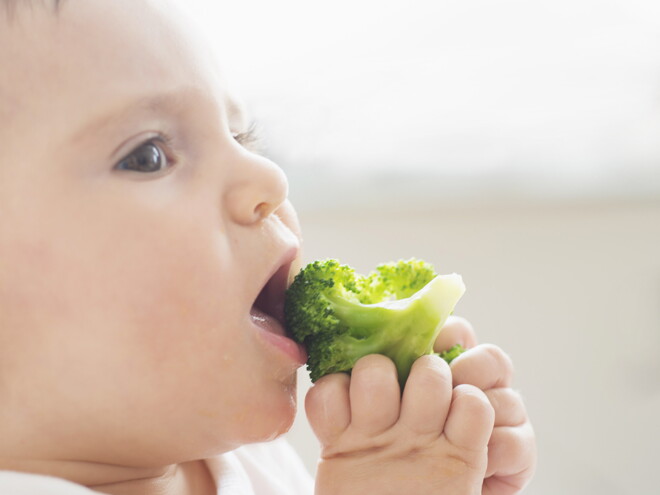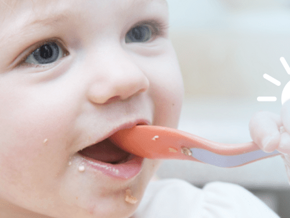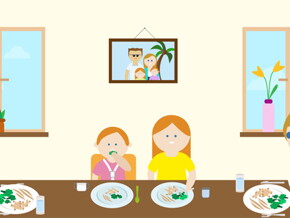
Toddler meals ideas | Nutrition and Feeding for Your Growing Toddler
Making sure he’s getting the proper nutrition along the way may seem like a challenge, especially when he spends so much time playing and exploring. Try not to worry too much about meeting all the requirements all the time. Look at your little one’s food intake over the week rather than over a day, developing healthy eating habits is about the big picture.
Along with solid foods, breast milk is still an important component of baby’s diet for up to 2 years and beyond, or for as long as you like.
Toddler nutrition: Introducing new foods
Continue introducing new foods for more variety. Offer foods with different textures, small bits of meat, pieces of dried toast, pasta bits and peeled, cut-up veggies and fruit are all foods that can help build your toddler’s acceptance of texture. The key is to introduce one new food at a time. And while you may think this sounds obvious, serve new foods when your child is hungry, but happy. He'll be more likely to give it a try. Let him smell and touch it, and at least take one bite, but don't force it if he's not interested because you can always try again later. In fact, you may find yourself offering foods up to 10 times before your toddler accepts them.
Variety helps build healthy eating habits
The foods that you offer your toddler will help to build healthy eating patterns now and as he grows. Be sure to introduce a wide variety of foods from all 4 of Canada’s Food Groups. Toddlers may eat about ¼ to ½ of what an adult eats at each meal or about ¾ to 1 full metric cup of food per sitting depending on their appetite. For a quick reference: ¼ cup is approximately an egg-sized portion, ½ cup about an ice cream scoop and 1 cup is about equivalent to a baseball.
Vegetables & fruits
Vegetables and fruits offer important nutrients such as vitamins, minerals and fibre. Offer a range of vegetables and fruits of different colours throughout the week, aiming for at least one dark green and one orange vegetable each day along with a variety of fruits. Try to add vegetables and fruits to each meal and snack.
Suggested serving sizes:
- ½ medium vegetable or fruit, peeled and cut up
- 2-4 tablespoons fresh, cooked, frozen or canned vegetables or fruit
Grains
Continue with iron-fortified multiple grain baby and toddler cereals as well as other grain products including whole grain bread, bagels and pastas. Include a variety of grains such as rice, barley, oats and rye. Iron-fortified baby and toddler cereals are still a reliable staple and provide a serving of grains as well as being an excellent source of iron, an essential nutrient for your little one’s normal growth and development.
Learn more about our iron-fortified Gerber® toddler cereal
Suggested serving sizes:
- 2 tablespoons – ½ cup iron-fortified multiple grain baby or toddler cereal
- ¼ - ½ slice of whole grain bread
- 1 – 4 tablespoons of cooked whole grain pasta, rice, or other grain
Milk & milk alternatives
Milk and milk products are an excellent source of calcium and vitamin D. Offer a maximum of 24 oz/720 mL of whole (3.25%) cow’s milk per day, so as not to suppress your toddler’s appetite or replace iron-rich foods. Your toddler needs 500 mg of calcium per day from higher fat milk sources.
Continue to offer breast milk or infant formula. At this age toddlers will generally eat about 24-32 oz or 720-960 mL each day, in combination with whole cow’s milk, if you’ve introduced it.
Suggested serving sizes:
- ¼ - ½ cup whole (3.25%) cow’s milk
- ½ - 1 oz bite-sized pieces of pasteurized cheese
- 2 tablespoons – ½ cup yogurt (3.25% or higher milk fat)
Meat & meat alternatives
Milk and milk products are an excellent source of calcium and vitamin D. Offer a maximum of 750 mL of whole (3.25%) cow’s milk per day, so as not to suppress your toddler’s appetite or replace iron-rich foods.1 Your toddler needs 500 mg of calcium per day from higher fat milk sources.
Continue to offer breast milk or infant formula. At this age toddlers will generally eat about 750-1000 mL each day, in combination with whole cow’s milk, if you’ve introduced it.
Suggested serving sizes:
- ¼ - ½ cup whole (3.25%) cow’s milk
- ½ - 1 oz bite-sized pieces of pasteurized cheese
- 2 tablespoons – ½ cup yogurt (3.25% or higher milk fat)
Protein foods
Most toddlers like the taste of red meats. To avoid choking hazards, offer minced, diced or shredded cooked tender meats and fish. Plant-based protein foods such as beans, lentils and tofu should also be part of your toddler nutrition plan. Protein foods are often an excellent source of iron.
Suggested serving sizes:
- 1 – 4 tablespoons bite-sized pieces of soft fish, poultry or lean meat
- 2 – 3 tablespoons mashed legumes
- 1 egg cut in bite-sized pieces
Looking for more meal ideas for your toddler? Explore our toddler recipes here.
How often do toddlers need to eat?
Toddlers should be offered 3-4 meals each day and, depending on their appetite, 1-2 snacks. This will keep your child's energy levels up and blood sugar levels constant all day, providing her with the fuel she needs to learn those new toddler skills. Just make sure you're not serving snacks too close to mealtime; 2 hours between meals will make sure your tot is hungry for the next meal. At around 16 to 18 months picky eaters are not uncommon.
How much food does your little one need?
Not as much as you think. In fact, you'll probably be surprised at how little your toddler needs. Little tummies between 1-2 years old need only about ¼ - ½ of what adults generally need, except for milk products. When preparing meals aim for about 3 servings from the different food groups as shown above. When it’s snack time, serve 2 servings of foods from the food groups as shown above. With all snacks and meals you can continue to offer breast milk, infant formula or you can offer whole cow’s milk. It’s recommended to keep cow’s milk under a maximum of 24 oz or 720 mL per day.
Because her appetite will vary from day to day, it's best to offer smaller portions, and have her ask for more. Don't worry, she'll let you know if she's still hungry, and when enough is enough. Plus, by asking for food when she's hungry, she'll start learning those cues that will help her establish healthy eating habits.
| Breakfast | Lunch | Dinner |
|---|---|---|
|
|
|
Keep these ideas in mind when offering healthy snacks during the day:
- Offer snacks when you notice crying and fussing, or hear rumbling tummies: your toddler may be hungry or thirsty, not just looking for entertainment.
- Don't overdo the liquids: although milk and some juices are nutritious, serve them in small portions and with solid foods; drinks should never replace food. Water is an excellent thirst-quencher that can be offered at any time.
- Don't offer drinks that are not nutritious; fruit crystals, pop, coffee or tea should not be given to toddlers. Although 100% fruit juice is a better choice than the other options listed here, limit her intake and provide real fruits and vegetables instead of juice whenever possible.
Wondering what foods to feed your little one? See Lunch Ideas for Toddlers.
Did you know?
During the second year of life iron-rich foods continue to be important for your toddler’s growth and development. Iron-rich foods include meat, meat alternatives and iron-fortified multiple grain baby or toddler cereals, such as Gerber® cereals, and should be offered 3 times per day. Offer a maximum of 24 oz/720 mL of whole (3.25%) cow’s milk per day, so as not to suppress your toddler’s appetite or replace iron-rich foods.
Family time
Make meals a time for the whole family to share. This doesn’t mean that you have to eat every dinner together but try to aim for three meals a week; maybe it’s a Sunday lunch, a Saturday breakfast or an afternoon snack. Even though meal times may seem hectic, know that just the simple act of being together regularly will provide benefits to your toddler and other family members. Meal times are one of the most common times that children communicate with their parents so try to keep meal times free of distractions such as TV so that you can focus on each other.
Eating together is also a chance for your little one to eat the same foods as the rest of the family. That is, as long as his portion is light on spicy or salty sauces and seasonings and prepared appropriately for his age. If you have a fussy eater, offering the same food to everyone at the table will give family members a chance to show your toddler how good the food is and may encourage your little one to give it a taste.
What you bring to the table
As the parent, you are responsible for feeding your toddler. You decide what foods you offer and where your little one eats. Your toddler is responsible for how much he eats and whether he eats the food that you have offered. Variety, healthy choices and trusting your child to decide how much and whether to eat are key factors when offering food at this age.
Simple steps to developing healthy eating habits
- Continue to offer new foods and flavours often so your little one learns to accept and enjoy a range of foods.
- Present new foods when he's happy and hungry.
- Introduce a new food along with familiar, preferred foods.
- Offer finger foods often, and in bite-size pieces.
- Offer your child a rainbow of choice. Brightly coloured vegetables and fruit look interesting to eat and provide a variety of nutrients.
- Offer small amounts of food at first, providing more as he asks for it.
- Avoid adding salt and excess spice to your toddlers foods.
- Make the plate interesting by serving a variety of different colours textures and flavours.
- Don't force your child to eat anything, instead, encourage him to 'try a bite' one at a time.
- Keep food neutral, don't use it to reward or bribe your toddler.
- Enjoy family time together, make meal time stimulating and full of conversation; keep the TV off while eating.
- Serve small meals and snacks at regular times to help ensure your toddler is hungry when it’s time to eat.
- Allow plenty of time for eating – 20 minutes is about the right amount of time for toddlers to be at the table.
- Meal time is a time to learn new skills and explore.
- Your toddler’s appetite can change every day. Trust his cues for hunger and fullness.
Most importantly, kids learn how to eat by watching you. Sitting as a family helps make meal times fun and sets a great example for your growing little person.
References:
1 Joint statement of Health Canada, Canadian Paediatric Society, Dietitians of Canada, and Breastfeeding Committee for Canada. Nutrition for Healthy Term Infants: Recommendations from Six to 24 Months. 2014. https://www.canada.ca/en/health-canada/services/food-nutrition/healthy-eating/infant-feeding/nutrition-healthy-term-infants-recommendations-birth-six-months/6-24-months.html
2 Canadian Paediatric Society, 2019. Healthy eating for children. Available at:
https://www.caringforkids.cps.ca/handouts/healthy_eating_for_children





















